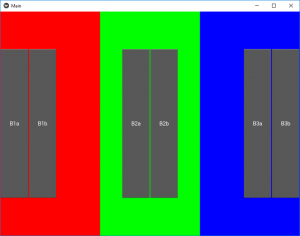Kivy是Python中与平台无关的GUI工具。由于它可以在Android, IOS, Linux和Windows等操作系统上运行。它基本上是用于开发Android应用程序, 但这并不意味着它不能在桌面应用程序上使用。
在本文中, 我们将看到如何使用多个.kv文件在单个应用中。
这是Python程序, 它使用网格布局作为根小部件。除了主要的kv文件, 它还会加载box1.kv, box2.kv和box3.kv。还有2个应用程序变量。这些变量是从主kv文件引用的。
??Kivy教程–通过示例学习Kivy。
Basic Approach:
1) import kivy
2) import kivyApp
3) import Gridlayout
4) import Builder
5) Set minimum version(optional)
6) Create Layout class
7) Create App class
8) Set up multiple .kv file
9) return Layout/widget/Class(according to requirement)
10) Run an instance of the classmain.py文件的实现:
# Multiple .kv file Python code
import kivy
# base Class of your App inherits from the App class.
# app:always refers to the instance of your application
from kivy.app import App
# The GridLayout arranges children in a matrix.
# It takes the available space and divides
# it into columns and rows, then adds
# widgets to the resulting "cells".
from kivy.uix.gridlayout import GridLayout
# Builder is a global Kivy instance used
# in widgets that you can use to load other
# kv files in addition to the default ones.
from kivy.lang import Builder
# Loading Multiple .kv files
Builder.load_file( 'box1.kv' )
Builder.load_file( 'box2.kv' )
Builder.load_file( 'box3.kv' )
# Creating main kv file class
class main_kv(GridLayout):
pass
# Create App class
class MainApp(App):
def build( self ):
self .x = 150
self .y = 400
return main_kv()
# run the App
if __name__ = = '__main__' :
MainApp().run()主kv文件包含一个包含3列的GridLayout。这3列包含不同的AnchorLayouts。这些都在主.kv文件。
现在是main.kv文件:
# Creating the main .kv files
# the difference is that it is
# the heart of the Application
# Other are just Organs
<main_kv>:
# Assigning Grids
cols: 3
# Creating AnchorLayout
AnchorLayout:
anchor_x: 'left'
anchor_y: 'center'
# Canvas creation
canvas:
Color:
rgb: [ 1 , 0 , 0 ]
Rectangle:
pos: self .pos
size: self .size
Box1:
size_hint: [ None , None ]
size: [app.x, app.y]
AnchorLayout:
anchor_x: 'center'
anchor_y: 'center'
canvas:
Color:
rgb: [ 0 , 1 , 0 ]
Rectangle:
pos: self .pos
size: self .size
Box2:
size_hint: [ None , None ]
size: [app.x, app.y]
AnchorLayout:
anchor_x: 'right'
anchor_y: 'center'
canvas:
Color:
rgb: [ 0 , 0 , 1 ]
Rectangle:
pos: self .pos
size: self .size
Box3:
size_hint: [ None , None ]
size: [app.x, app.y]现在, 如输出中所示, 每个网格中都有不同的按钮来创建按钮
在每个网格中, 我们都使用不同的.kv文件。
box1.kv文件–
# Creating 1st .kv file
<Box1@BoxLayout>:
Button:
text: 'B1a'
Button:
text: 'B1b'box2.kv文件–
# Creating 2nd .kv file
<Box2@BoxLayout>:
Button:
text: 'B2a'
Button:
text: 'B2b'box3.kv文件–
# Creating 3rd .kv file
<Box3@BoxLayout>:
Button:
text: 'B3a'
Button:
text: 'B3b'输出:

首先, 你的面试准备可通过以下方式增强你的数据结构概念:Python DS课程。
 srcmini
srcmini
评论前必须登录!
注册